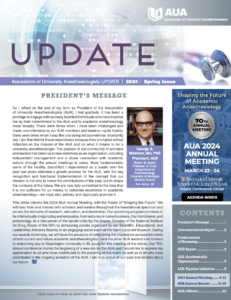Host Program Report from the 2019 AUA Annul Meeting
Host Program Panel I
University of Montreal
The first host program was moderated by Pierre Beaulieu, MD, PhD, FRCA, University of Montreal, and included “The Analgesic Power of Music” by Isabelle Pertez, PhD, University of Montreal, and “Computerized Clinical Decision Support for the Management of Critically Ill Patients” by Philippe Jouvet, MD, PhD, FRCA, University of Montreal.
“Computerized Clinical Decision Support for the Management of Critically Ill Patients”
In intensive care, the standardization of care with protocols improves patient outcomes and the more detailed the protocol is, the best the standardization of care is. Computerized clinical support systems (CDSS) are made of a set of standardized rules, with detailed explicit instructions based on dynamic patient-specific parameters and available at the point-of-care. CDSS are usually developed in open loop where a recommendation is displayed and an active intervention by the clinician is required to apply this recommendation. After a validation phase, CDSS can be implemented in closed loop, for example for ventilation management where ventilator settings are dynamically adjusted to a patient’s condition according to the CDSS recommendations without caregiver intervention. This presentation detailed how to create and validate CDSS in an intensive care environment.
Host Program Panel II
McGill University
The second host program was moderated by Thomas Schricker, MD, PhD, McGill University, and included “History of Anesthesia in Montreal: 1847 to 1955” led by Daniel Chartnund MD, PhD, FRCA, Montreal Neurological Hospital, “Genetics of Pain” by Luda Diatchenko, MD, PhD, McGill University, and “Pain in Mice and Man: Ironic Adventures in Translation” by Jeffrey S. Mogil, PhD, McGill University.
“History of Anesthesia in Montreal: 1847 to 1955”
In January 1847, anesthesia research had already started in Montreal. Dr Horace published the first Canadian anesthesia research article in May 1847. Later in the 19th Century, Sir William Hingston, President of the Canadian Medical Association and Honorary President of the British Medical Association, wrote several articles about anesthesia. He was hoping that some doctors will devote themselves solely to the practice of anesthesia…In 1906, Dr. Hingston’s dream became a reality when Dr Charles Larocque became the first anesthesiologist in Quebec. Dr. Larocque will become a President of the first Canadian Society of Anaesthetists and was an important link with the rest of North America. When he died in 1932, the IARS paid him tribute with a beautiful bronze plate.
In 1907, Dr. Francis W. Nagle became the first anesthesiologist at McGill. He published several articles and was a leader of “modern” insufflation anesthesia. In 1917, he became the President of the American Association of Anesthetists, but he unfortunately died on that same year. Leadership in academic anesthesia was then taken over by Dr. Wesley Bourne. Dr. Bourne was a founder of the first Canadian Society of Anaesthetists in 1922 and of the actual Canadian Anesthesiologists’ Society in 1943. In 1926, he was the “Builder of Bridges” who created the “Associated Anesthetists of United States and Canada” which will merge with the IARS in 1941. In 1942, he became the only non-American President of the American Society of Anesthesiologists. Later he became the first Chairman of the Department of Anesthesia at McGill University (which is also the first academic anesthesia department in Canada).
After introducing the use of curare for surgical procedures in 1942, D.r Harold Griffith became the first President of the Canadian Anesthesiologists’ Society in 1943. In 1948, he became President of the IARS and also Vice-President of the ASA. He was involved in the IARS Board of Trustees from 1948 to 1961 and, participating in the creation of the World Federation of Societies of Anesthesiologists, he became the Founding President of the WFSA in 1955.










